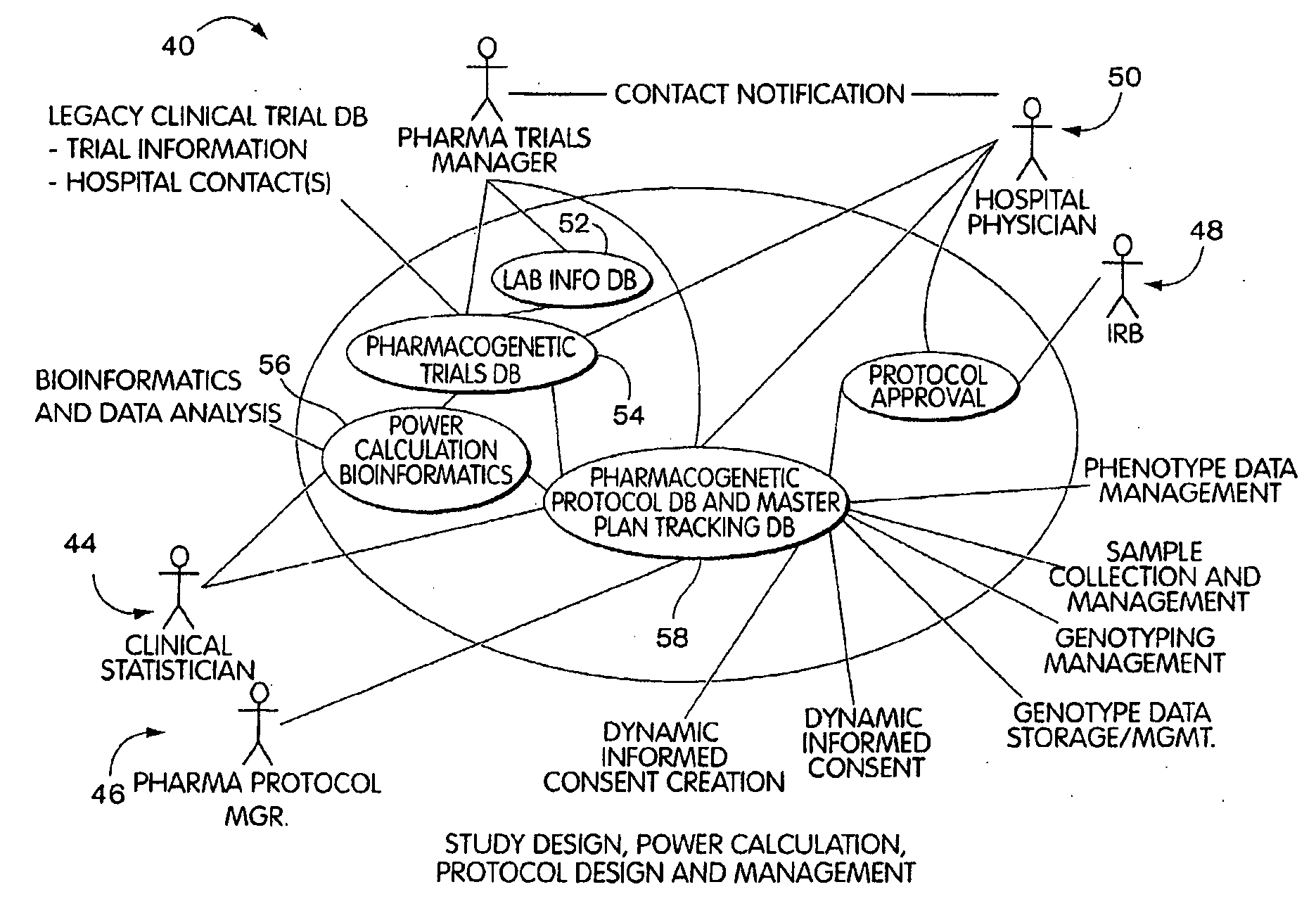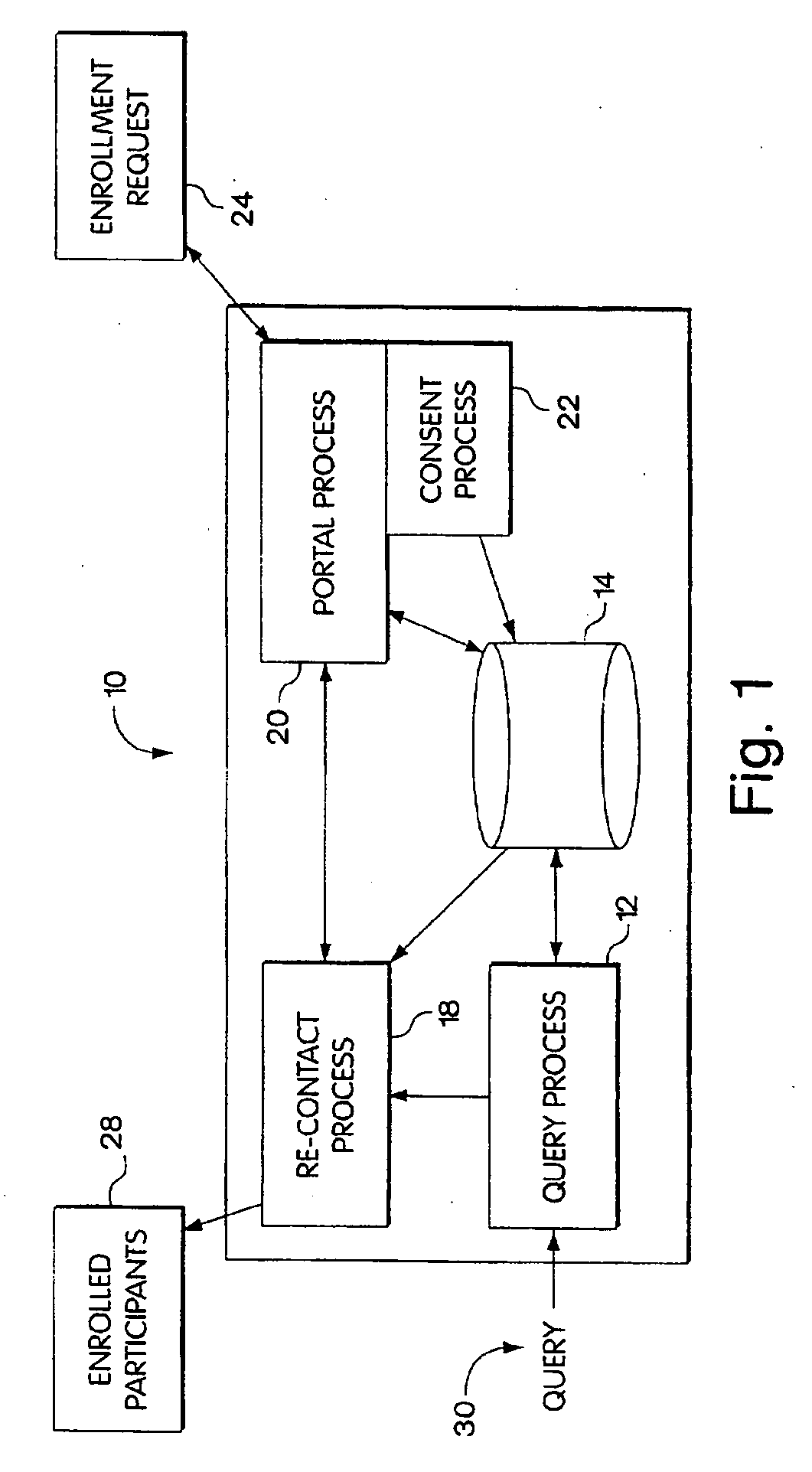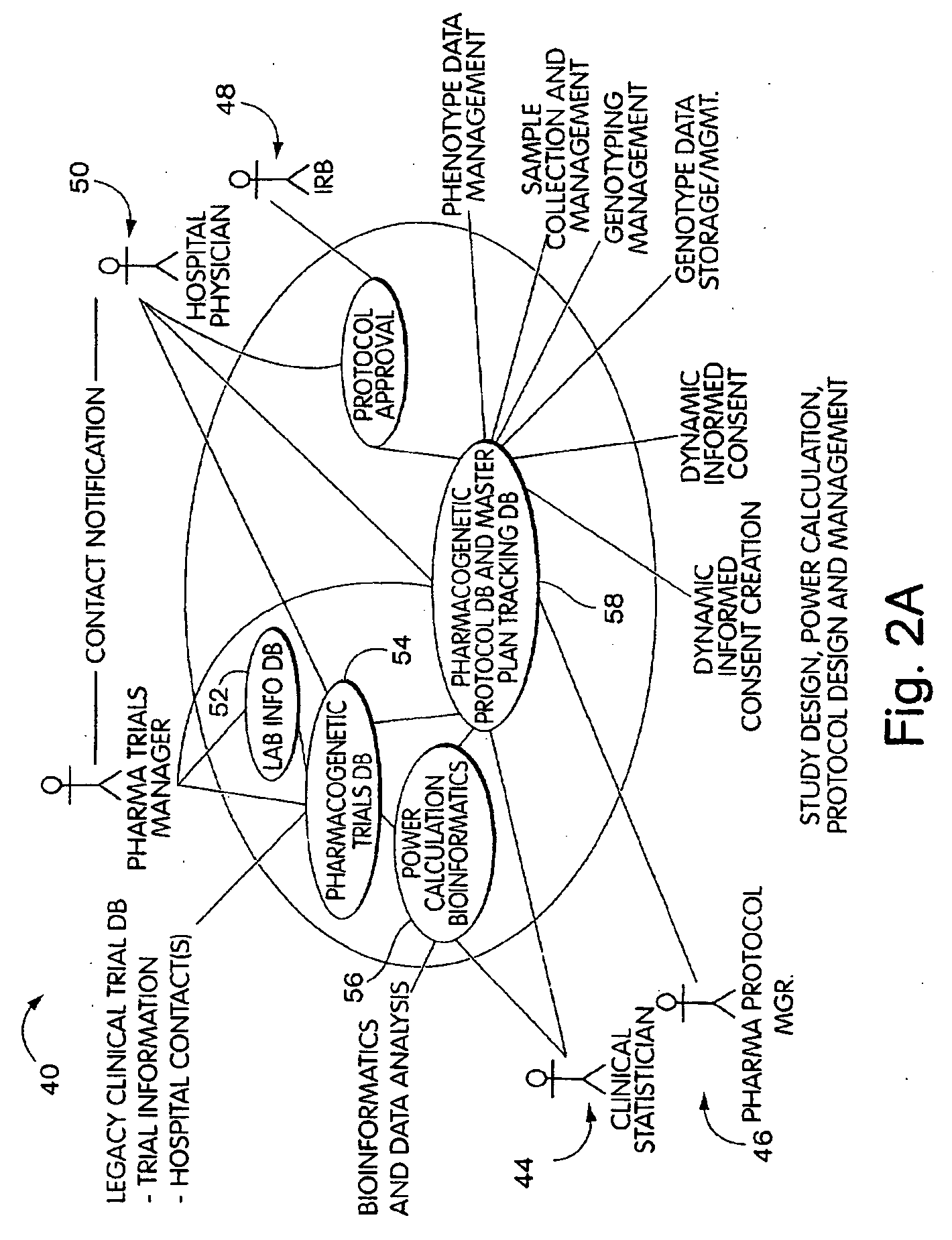[0012] The systems and methods described herein include, inter alai, systems that allow a person to control the use of their medical and
biological data on a continuous, selective and dynamic manner. Specifically, the systems described herein include systems that allow a person to store or have stored into a
database their medical and
biological data. Along with the medical and
biological data, the person stores a grant of consent that indicates the types of activities and uses to which the person agrees or consents. The
database links the stored data with the granted consent As it can be difficult for a person to understand what kind of consent should be granted, in one embodiment, the
system helps the person determine what grant of consent to provide. To this end, the
system can guide the person through a process that helps the person complete a consent form that indicates the different allowed uses for the data. In a preferred embodiment, each grant of consent includes an indication as to whether the person is willing to be re-contacted at a later to date, wherein the re-contact is typically for the purpose of requesting the person to consent to a new treatment or use of their medical, genetic, demographic or biological data. The grant of consent may be stored in a database along with and in association with the medical, genetic, and / or biological data.
[0016] In further embodiments, the process may include having a
trusted third party control access to the stored medical and
genetic data. The
trusted third party may also broker correspondence between the interested parties and the human subject, thus providing greater security that interested parties will not determine the identity of the human subjects that have provided data. Thus in certain practices, the processes allow for contacting the human subjects by having a
trusted third party contact the human subjects.
[0017] To further provide for privacy and
anonymity, the processes may allow for encrypting the data, or portions of the data, that is stored in the
data memory. In this process, the human subject may be allowed to store portions of the medical and
genetic data as clear text and other portions in an encrypted format. Optionally, the human subjects may further be able to control which portions of the stored data may be searched by an interested party and which portions of the stored data are to remain private. In further practices, the human subject may further designate controls over what types of interested parties may look at certain portions of the stored data. Thus, the human subject may allow certain types of interested parties, such as academic researchers, to view all the stored data while other types of interested parties, such as pharmaceutical companies, may be provided more
limited access to the stored data In either case however, data that is encrypted for storage, in some embodiments, may be made available in clear text format to the query mechanism to allow for searching on encrypted data Thus, in certain embodiments, the human subject encrypts data stored within the
data memory for the purpose of protecting that data while it is stored. However, during queries run by interested parties, the processes may allow the interested parties to search on encrypted data, typically by decrypting the data during the
data query process, so that this data may be viewed by the interested parties that the human subject has authorized to view that data.
[0020] Optionally, the process may contact the identified human subjects, thus providing the interested party with a platform for identifying and contacting human subjects that may benefit from participating in an action, procedure or study. When contacting the human subjects that process may provide to the human subjects information that is representative of the required grant of consent that that human subjects will need to agree to in order to participate in the action or procedure. The processes therefore will allow the human subject to change consent stored in the
data memory. In the processes described herein the human subject may change the consent stored in the data memory in response to a request to change the consent, or, optionally, at their own volition and unprompted. The human subject can change the consent data in any manner that they choose, including expanding the granted level of access and rights to the stored data, reducing the granted level of access and rights, and eliminating altogether the ability to access or use the data. Additionally, the user can expand,
restrict, or eliminate the types of parties that are authorized to query the data that they have stored, or to recontact them. For example, the human subject may
restrict access to data to only trusted intermediaries. Thus it will be understood to those of ordinary skill in the art that the systems and methods described herein provide a platform that offers the human subject a substantial amount of flexibility in controlling how their data is used and who can use it.
[0021] In a further aspect, the invention will be understood to provide systems for managing access to
medical record and genetic information of an individual and to allow a researcher or clinician or other biomedical professional to find participants for a study. The systems may comprise a database that has storage for
medical record an biological data of an individual and that has storage for consent data that is representative of a limited grant of informed consent provided by the individual for the data. The database can link the consent data with the stored
medical record and biological data. The systems further comprise a query tool that allows a researcher to query the medical
record data to identify an individual of interest to the study and that returns to the researcher the consent data that is associated with medical
record data that matches the query. The system further includes a
contact mechanism that can be a computer process, and that allows the biomedical professional to indicate a required grant of consent for the study and to contact the individual and request the individual to grant the necessary informed consent. The system further includes a
response process that allows the individual to participant in the study by granting the new consent and associating the new consent with the data provided by the individual.
[0022] Optionally, the systems may include data storage for biological sample data, medical data and
genetic data. Storage systems for physical storage devices may be incorporated into the systems as well. Thus, in some embodiments
refrigeration storage systems for storing samples, such as tissue samples, may be integrated into the systems described herein. In one embodiment, access to the sample storage systems may be controlled as well as monitored by the systems described herein. To this end, these systems may include
access control devices that verify access requests against a stored level of informed consent provided by the human subject. The systems may further include a network
web server for providing access over a data network. In these embodiments, a
web server may be included to provide a portal that gives network access to both researchers and individuals. The portal may a secure website that requires a
password and user name to log on to and access. Thus the portal may provide a secure mechanism for allowing authorized individuals to have easy access to the system for the purpose of managing how their data is to be used. At the same time, the
web server may be employed as a portal to present information to authorized user. Thus a biomedical professional may be interested in conducting a study and, through querying the stored data, may have identified a group of individuals that may benefit from the study. The biomedical professionals may generate a description of the study and the benefits that it may hold. At the same time the biomedical professionals may create an appropriate informed consent form. The biomedical professionals may deliver to the system the description of the study and the required informed consent form and the system may post the description and informed consent form to each of the individuals identified by the biomedical researcher. Thus in one embodiment, when an authorized user logs on to the portal, they will be presented with a
web page that describes a study from which the
database query indicates that they may benefit. The
web page may further include a link to the required informed consent. At the discretion of the individual, the individual may agree to join the study by granting the required level of consent and having the required level of consent be associated with their stored data. Optionally, the portal may identify the targeted individuals that have granted the required level of request and provide this information to the researcher. In this way, the systems and methods described herein provide a facile system for allowing a biomedical professional to enroll participants into a study or procedure that they are conducting.
 Login to View More
Login to View More  Login to View More
Login to View More 


